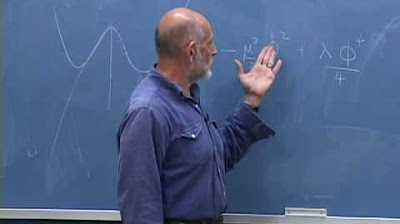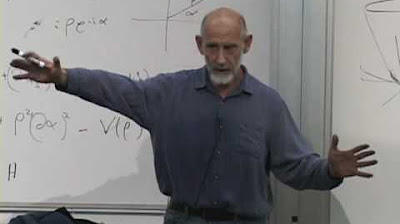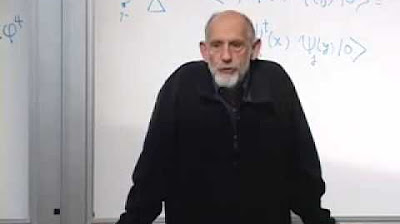Special Relativity | Lecture 5
TLDRThe provided transcript appears to be a lecture on theoretical physics, focusing on the concepts of relativity, quantum mechanics, and field theory. The lecturer discusses the Doppler shift, Lorentz transformations, and the interplay between fields and particles. They delve into the Klein-Gordon equation, a fundamental equation in quantum mechanics that describes particles with mass. The lecture also touches on the Higgs boson and its role in particle physics, particularly how it is responsible for giving particles mass through interaction with the Higgs field. The lecturer uses the principles of least action and the construction of scalars from vectors to explain the underlying mathematics of these physical phenomena. The summary of this transcript would highlight the educational content on advanced physics topics aimed at students or individuals with a strong interest in the field.
Takeaways
- 🌌 The Doppler Shift describes how the wavelength of light changes depending on the relative motion between the source and the observer, with the Lorentz Transformations key to understanding this effect.
- 🚀 When approaching the speed of light, wavelengths increase (get longer) if moving with the light and decrease (get shorter) if moving against it, which is crucial for understanding relativistic effects.
- 📐 Geometry and the Lorentz Transformations can be used to calculate the Doppler Shift, providing a deeper understanding of how relative motion affects the perception of light waves.
- 🧲 The concept of action and reaction in physics implies that fields and particles influence each other, with the Lagrangian principle illustrating how these interactions are reciprocal.
- 🤔 The non-relativistic limit is an approximation that assumes the speed of light is much larger than other velocities in the problem, simplifying calculations and revealing the underlying physics.
- 🌟 The Higgs boson is responsible for giving particles mass through interaction with the Higgs field, a fundamental concept in particle physics that explains mass acquisition.
- 🧬 Protons and neutrons do not acquire mass through the Higgs mechanism; their mass is derived from other quantum mechanical effects, unlike some other particles.
- 📉 In the absence of the Higgs field, certain particles like electrons and neutrinos would become massless, leading to a destabilization of atoms and significant changes in the universe.
- 🔧 The Lagrangian for a scalar field is a scalar, which means it remains invariant under Lorentz transformations, a requirement for the principle of least action to hold across different frames of reference.
- 📚 The metric tensor (η) is used in special relativity to raise or lower indices of four-vectors, simplifying the notation and allowing for more elegant expressions of physical laws.
- ✨ The Klein-Gordon equation is a relativistic wave equation that can be derived from a Lagrangian and is used to describe particles with mass in quantum mechanics.
Q & A
How does the Doppler shift affect the measurement of a wavelength for a person traveling near the speed of light?
-The Doppler shift causes a person traveling near the speed of light to measure a different wavelength depending on their direction relative to the light wave. If the light wave is moving in the same direction as the person, the wavelength appears longer; if it's moving in the opposite direction, the wavelength appears shorter.
What is the Lorentz transformation and how is it used to calculate the Doppler shift?
-The Lorentz transformation is a set of mathematical equations that describe the relationship between two observers moving at a constant velocity relative to each other. It is used to calculate the Doppler shift by comparing the distances between successive wave maxima in different reference frames.
What is the significance of the speed of light in the context of the lecture?
-The speed of light is a fundamental constant in the context of the lecture, as it is used to illustrate the principles of special relativity, including the Doppler shift and the Lorentz transformation. It also appears in the Lagrangian for a particle moving at relativistic speeds.
How does the presence of a particle affect the field in the context of field theory?
-In field theory, the presence of a particle affects the field through the principle of least action. The particle's motion and the field's behavior are described by a combined action that includes contributions from both. The field responds to the particle because the Lagrangian for the particle involves the field, and vice versa.
What is the Klein-Gordon equation and how is it derived?
-The Klein-Gordon equation is a relativistic wave equation that arises from the quantization of the energy-momentum relation in the context of special relativity. It is derived from a Lagrangian density that includes second-order time derivatives and spatial derivatives of a scalar field, leading to a wave equation for the field.
How does the Higgs boson give mass to particles?
-The Higgs boson is associated with the Higgs field, a scalar field that permeates all of space. When particles interact with this field, they acquire mass. The strength of the interaction between a particle and the Higgs field determines the mass of the particle.
What is the non-relativistic limit and how does it relate to the Lagrangian of a particle?
-The non-relativistic limit is the approximation where the speed of light is considered to be infinitely large compared to other velocities in the problem. In this limit, the Lagrangian for a particle simplifies to the sum of its kinetic energy and potential energy, which is a more familiar form from classical mechanics.
What is the role of the metric tensor in special relativity?
-The metric tensor, denoted by gμν, is used in special relativity to define the spacetime interval, which is invariant under Lorentz transformations. It allows for the construction of scalar quantities from four-vectors and facilitates the raising and lowering of indices in tensor notation.
What is the difference between covariant and contravariant four-vectors?
-Covariant and contravariant four-vectors differ in the sign of their time component when transformed under Lorentz transformations. A contravariant four-vector has an upper index, while a covariant four-vector has a lower index. The metric tensor is used to convert between these two forms.
How does the Lagrangian density for a scalar field lead to the wave equation?
-The Lagrangian density for a scalar field includes terms involving the field's time derivatives and space derivatives. Varying this density with respect to the field yields the Euler-Lagrange equation, which is a wave equation describing the dynamics of the field.
What is the principle of least action and why is it important in physics?
-The principle of least action is a fundamental principle in physics which states that the path taken by a system between two points in its configuration space is the one for which the action is minimized. It is important because it leads to the equations of motion for the system and ensures that these equations are the same in all reference frames, thus maintaining physical laws' consistency across different observers.
Outlines
📐 Understanding Doppler Shift Through Geometry
The first paragraph introduces the concept of Doppler Shift and its relation to the speed of light and the observer's movement. It discusses how the wavelength appears longer or shorter depending on the relative motion between the observer and the light wave, and how this can be calculated using the Lorentz Transformations. The speaker recommends using these transformations as an exercise to understand the geometrical aspects of the Doppler Shift.
🌌 Quantum Mechanics and General Relativity: Future Course Content
The second paragraph explores potential topics for future lectures, such as quantum mechanics and general relativity. The speaker acknowledges the need for a deeper understanding of quantum mechanics before delving into quantum field theory. They also mention the importance of studying gravity, which combines quantum mechanics and general relativity, and touch upon the Lorentz Transformations in the context of locating points in space-time.
🚀 Relativistic Doppler Shift Formula and Its Implications
The third paragraph delves into the specifics of the relativistic Doppler Shift formula. It discusses the formula's components, the implications of moving towards or away from a light source, and the effects of approaching the speed of light. The speaker uses the formula to illustrate how the wavelength changes with velocity and emphasizes the importance of visualizing the scenario to solve problems.
🧲 Action Principle and the Interplay Between Fields and Particles
The fourth paragraph introduces the concept of fields and particles and their mutual influence. It discusses the action principle, which dictates that if a field affects a particle, the particle must also affect the field. The speaker uses the example of two coordinates and an action principle to explain how interaction between the field and particle can be represented mathematically.
🌠 Field Lagrangian and the Effect of Particles on Fields
The fifth paragraph discusses the Lagrangian for a particle and how it can be influenced by a field. The speaker simplifies the scenario by considering a particle moving slowly and introduces a coupling constant to measure the field's effect on the particle's motion. The Lagrangian is then used to derive the non-relativistic limit and identify the potential energy of the particle in a field.
🤔 The Combined Action of Particles and Fields
The sixth paragraph focuses on the combined action of a field and a particle moving through it. The speaker explains the process of minimizing the action to find the trajectory and field configuration that adhere to the principle of least action. They also present the action for the field and discuss adding the particle's contribution to this action.
📓 Using Delta Functions to Represent Particles in Fields
The seventh paragraph explores the use of delta functions to represent particles within the context of fields. The speaker demonstrates how to integrate over space-time to account for the particle's contribution to the field's action. They also show how to modify the equation to accommodate a moving particle and the resulting time dependence of the field.
🎓 Relativistic Notation and Four-Vectors
The eighth paragraph reviews the mathematical notation used in relativity, focusing on four-vectors and scalars. The speaker explains how to construct scalars from four-vectors and introduces the metric tensor. They also discuss the Einstein summation convention and the distinction between contravariant and covariant vectors.
🌐 The Klein-Gordon Equation and its Solutions
The ninth paragraph introduces the Klein-Gordon equation, a relativistic wave equation that arises from a Lagrangian involving a scalar field. The speaker derives the equation and discusses its solutions in terms of plane waves. They also explain how the solutions represent oscillations in space and time and how the real part of these complex solutions can be used if the field is real-valued.
🤓 The Higgs Boson and the Concept of Mass in Particle Physics
The tenth paragraph discusses the Higgs boson and its role in particle physics, particularly in conferring mass to particles. The speaker explains how the Higgs mechanism works and how different coupling constants can lead to different masses for particles. They also touch upon the implications of a world without the Higgs boson, where certain particles would become massless.
🔬 Further Exploration of the Higgs Boson and Superconductivity
The eleventh paragraph continues the discussion on the Higgs boson and its implications for physics, including superconductivity. The speaker addresses questions about the Higgs boson, the mass of particles, and the potential visualization of how the Higgs boson creates mass. They also briefly mention the topic of superconductivity and its connection to the Higgs mechanism.
🏁 Conclusion and Further Resources
The twelfth paragraph serves as a conclusion and a prompt for further learning. The speaker directs interested individuals to Stanford's website for more information, indicating the end of the discussion on the Higgs boson and related topics in particle physics.
Mindmap
Keywords
💡Doppler Shift
💡Lorentz Transformations
💡Wavelength
💡Special Relativity
💡Quantum Mechanics
💡General Relativity
💡Infrared and Ultraviolet
💡Action Principle
💡Lagrangian
💡Scalar Field
💡Higgs Boson
Highlights
Discussion on the Doppler Shift and its relation to the speed of light and observer motion.
Explanation of how to calculate the Doppler Shift using Lorentz Transformations.
Introduction to the concept that fields and particles are interconnected in quantum mechanics.
Derivation of the relativistic Doppler shift formula and its implications for wavelength perception.
Insight into the action principle and how it implies a mutual influence between fields and particles.
Use of the Lagrangian to describe the dynamics of a particle influenced by a field.
The potential energy of a particle in a field is identified as a key component in the Lagrangian.
Explanation of how a particle at rest affects the field it is in, using the principle of least action.
Introduction to the concept of four-vectors and their significance in special relativity.
Discussion on the notation and mathematical conventions used in relativistic physics.
The derivation and solution of the wave equation, specifically the Klein-Gordon equation.
Explanation of how the Klein-Gordon equation is related to the quantum mechanical description of particles.
Discussion on the physical interpretation of solutions to the Klein-Gordon equation as waves.
The Higgs boson and its role in creating mass for particles through interaction with fields.
Differentiation between particles that acquire mass through the Higgs mechanism and those that do not.
Implications of a hypothetical scenario where the Higgs field disappears, affecting fundamental particles.
The importance of the Higgs boson for the stability of atoms and the structure of the universe.
Transcripts
Browse More Related Video

Lecture 10 | New Revolutions in Particle Physics: Standard Model

Lecture 8 | New Revolutions in Particle Physics: Standard Model

Supersymmetry & Grand Unification: Lecture 3

Advanced Quantum Mechanics Lecture 8

Lecture 1 | New Revolutions in Particle Physics: Standard Model

Demystifying the Higgs Boson with Leonard Susskind
5.0 / 5 (0 votes)
Thanks for rating: